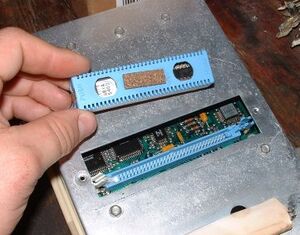Difference between revisions of "Holden:Power-train Control Module"
Tags: Mobile web edit Mobile edit |
|||
| Line 2: | Line 2: | ||
== 3800 Engines == | == 3800 Engines == | ||
| + | |||
| + | [[File:Tpiecm-memcal-removed.jpg|thumb|right|3800 PCM with the Memcal module removed]] | ||
The '''L36''' and '''L67''' 3800-series engines use a single PCM for both engine and transmission management based on the [https://en.wikipedia.org/wiki/Motorola_68HC11 Motorola 68HC11] 8-bit microcontroller. On the majority of L36 and L67 PCMs, firmware, calibration data and software configuration are stored on a single UV-erasable PROM chip within a cartridge inside the PCM. This cartridge is known as the '''Memcal''', and is accessible via a small cover on the PCM held in place by a single screw. Some PCM models however (such as the naturally-aspirated L36 in the VY Commodore) use a non-removable internal flash chip for storage. Flash PCMs have the advantage of being re-programmable via the diagnostic link connector. | The '''L36''' and '''L67''' 3800-series engines use a single PCM for both engine and transmission management based on the [https://en.wikipedia.org/wiki/Motorola_68HC11 Motorola 68HC11] 8-bit microcontroller. On the majority of L36 and L67 PCMs, firmware, calibration data and software configuration are stored on a single UV-erasable PROM chip within a cartridge inside the PCM. This cartridge is known as the '''Memcal''', and is accessible via a small cover on the PCM held in place by a single screw. Some PCM models however (such as the naturally-aspirated L36 in the VY Commodore) use a non-removable internal flash chip for storage. Flash PCMs have the advantage of being re-programmable via the diagnostic link connector. | ||
| − | |||
| − | |||
=== Modifications === | === Modifications === | ||
Revision as of 12:27, 20 April 2021
The Power-train Control Module or PCM is the module responsible for management of the engine and transmission.
3800 Engines
The L36 and L67 3800-series engines use a single PCM for both engine and transmission management based on the Motorola 68HC11 8-bit microcontroller. On the majority of L36 and L67 PCMs, firmware, calibration data and software configuration are stored on a single UV-erasable PROM chip within a cartridge inside the PCM. This cartridge is known as the Memcal, and is accessible via a small cover on the PCM held in place by a single screw. Some PCM models however (such as the naturally-aspirated L36 in the VY Commodore) use a non-removable internal flash chip for storage. Flash PCMs have the advantage of being re-programmable via the diagnostic link connector.
Modifications
Due to the simplicity of the addressing scheme on the PROM-based PCMs, a number of modifications are possible to enable features commonly found in aftermarket ECUs such as map switching, and realtime tuning. Selecting maps at runtime is possible using techniques such as bank switching on the Memcal itself. This involves using a higher capacity PROM chip, and assigning one or more of the additional address lines, as "switches" to select different memory regions from which the ECU will retrieve data[1].
LS Engines
The Gen III LS engine is managed by a separate ECU based on the Motorola 68332 32-bit microcontroller. On VT/VX/VY/VZ Commodores, this ECU integrates with the original 3800 PCM via a separate module, the Power-train Interface Module or PIM. Since the Gen III ECU only communicates via CAN bus, the PIM is needed to translate CAN messages into ALDL messages, and vice-versa. The original 3800 PCM is retained for control of the 4L60-E automatic transmission, however engine management functions are disabled via software configuration. Scan tools and other diagnostic equipment communicate with the Gen III ECU directly over CAN bus (exposed on the OBD port using pins 6 and 14).

